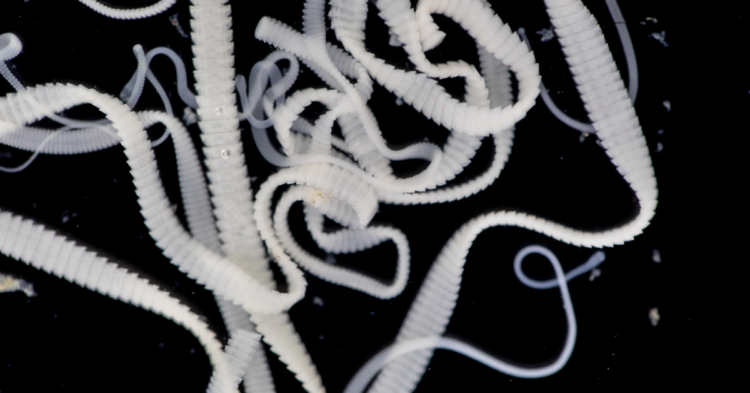Some Tapeworm Species and their Associated Diseases:
Tapeworms (Taenea spp.) Infection with a tapeworm is called Taeniasis, but each species of tapeworm (and there are many not listed here) create their own disease. I’ve listed these diseases under each type of tapeworm discussed where pertinent (see list at bottom).
Tapeworms are in the Class Cestoda.
There are two Orders of Cestodes:
- Pseudophyllidea–the fish tapeworms and
- Cyclophyllidea–tapeworms infecting domestic animals
There are several Families of Cyclophyllidea. These are:
- Taeniidae, the most important, that are found as adults in carnivores (Man, Dogs and Cats)
- Anaplocephalidae–tapeworms in grazing animals gotten from eating the cystacercoid. These tapeworm eggs are square.
- Dipylidiidae–Dogs and cats eat the intermediate host (flea) that contains the infective stage which matures as a tapeworm in about three weeks.
- Davaineidae–Tapeworms in poultry who eat infected beetles.
- Hymenolepididae–Half-inch tapeworms people get from rat and mouse feces who eat infected beetles.
- Mesocestoididae--A dog tapeworm gotten from eating infected sheep that can in turn infect humans by getting into their brains.
Tapeworms are flat like a ribbon, and made up of segments called proglottids. Each proglottid contains a genital opening but both sexes are in each proglottid. These proglottids contain between 50 to 60,000 eggs. As the tapeworm grows, the proglottids eventually break off and exit via the anus. Tapeworms live in the small intestine and they anchor into the intestinal wall by means of a scolex (head with several hooks, allowing it to adhere to the intestinal wall. Some tapeworms also have a suction cup on the head called the acetabula.
The tapeworm eggs, which can be seen in the fecal floatation under a microscope, are spherical, measure from 30-45 um, and contain in their interiors the oncosphere. These eggs are very resistant to environmental conditions and can remain infectious for long periods of time. These off-white segments look like rice (until they move!) or can as small as a sesame seed after they have dried up. Look closely at these pictures. In the center of the egg you can imagine the scolex. The tapeworm egg also has this very thick coat which other worm eggs do not have. They type of tapeworm is identified by measuring the size of the egg and looking at the head (scolex) to count the teeth, suction cups and by looking at the shape of the segments in the intact adult worm. Some of the wormed can be 10-15 meters in length!
Common Sources of Infection— Prevention of tapeworms in people would include eliminating any fleas on the pet and in the environment, not allowing pets to consume rodents and other intermediate hosts, practicing good personal hygiene, preventing fecal contamination of food and water, and not eating uncooked or undercooked meat/fish. What? You say you don’t eat raw meat? Ever use a cold steak as a compress? Well, you can get parasites in your eyes and under your skin if that meat is infected.
It takes an intermediate host for the parasite to develop into a mature worm because it needs special nutrients in one animal that it can’t get in the last animal it matures in. Intermediate hosts can include fish, amphibians, reptiles, birds, mammals of all kinds, family pets, and rodents. Insects such as ants, beetles, cockroaches, flies and fleas when ingested can also give us tapeworms. Children are susceptible to worms because they put so many things into their mouths. I can’t imagine how many people get infested with all kinds of worms eating what they do on those reality shows!
Symptoms of Taeniasis: Diarrhea, anorexia, nausea, vomiting, anal itching, colic, ascites, headaches and weight loss are common symptoms of having tapeworms. With severe infections hives, fever and convulsions can also occur. Sometimes they embed in the tissues causing intestinal nodules or cysts in the skin, lung or liver. An animal or human with a tapeworm may also have a craving for salt. The tapeworms also compete with the organism for Vitamin B 12, so slight anemia can occur. Seen under a microscope, the red blood cells are immature looking and darker in color than mature red blood cells.
Tapeworms are diagnosed by seeing the fresh or dehydrated segments around the anus or on the hair or underwear or by seeing the eggs under a microscope after doing a fecal floatation. The proglottids are motile when freshly passed and may be mistaken for maggots or fly larvae. Please note that if there are only a few tapeworms, they will nest in the small intestine and the doctor may not see the eggs under the scope. It’s also difficult to convince the doctor to do a fecal exam sometimes (in the human medicine world, not the animal medicine world.)
Lifecycles of the tapeworm are complex and the infective stages can be harmful to the host but the adults are not very pathogenic (disease-causing).
Treatment for Tapeworms: Praziquantel, Epsiquantel (Cestex), Niclosamide, Quinacrine
One gross fun fact for you. A couple decades ago they used tapeworms as a dietary aid. The person wanting to lose weight ate the tapeworm segments after they were put into a gelatin capsule. When they lost the weight they wanted to (the worms do use up a lot of nutrition) then the person would worm themselves and see the worms pass in the toilet. Gross, eh?
Reference: https://www.dpd.cdc.gov/dpdx/HTML/ImageLibrary/Taeniasis_il.htm
Helpful Links and References:
- Tapeworm (Cestode) Species
- Tapeworm-Diphyllobothrium latum (from fish to humans via sushi and other raw or pickled fish)
- Tapeworm-Dipylidium caninum (From fleas) (fleas to dogs, cats and wild canids)
- Tapeworm-Echinococcus (sheep to dogs to humans)
- Tapeworm-Hymenolepis (fish to humans)
- Tapeworm-Sparganosis (Cyclops snail to water plants-like watercress- to humans)
- Tapeworm-Taenea saginata (beef to humans)
- Tapeworm-Taenia pisiformis (from rodents to animals)
- Tapeworm-Taenia solium (Pork) (pigs to humans)

